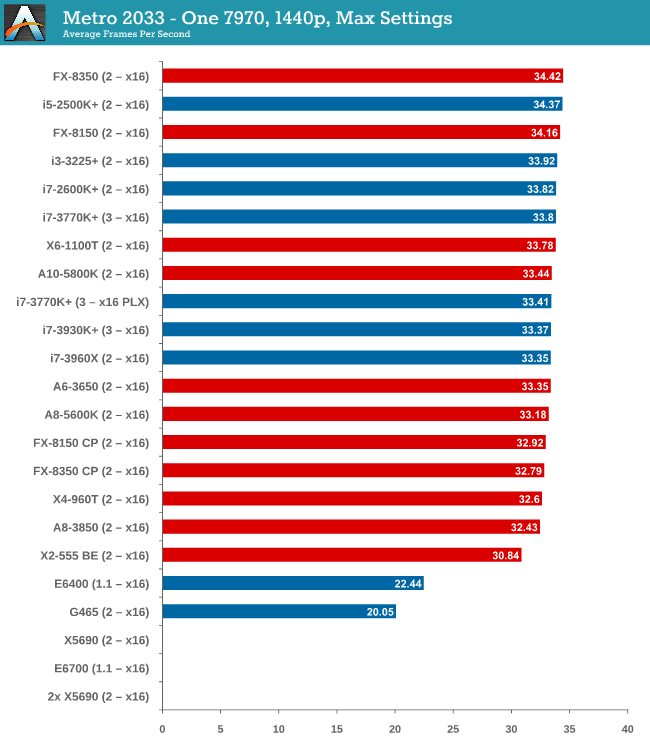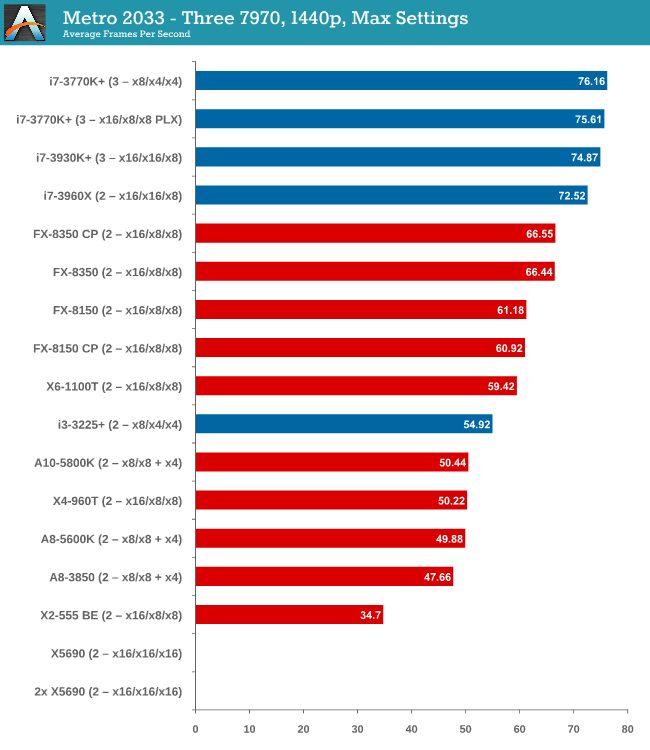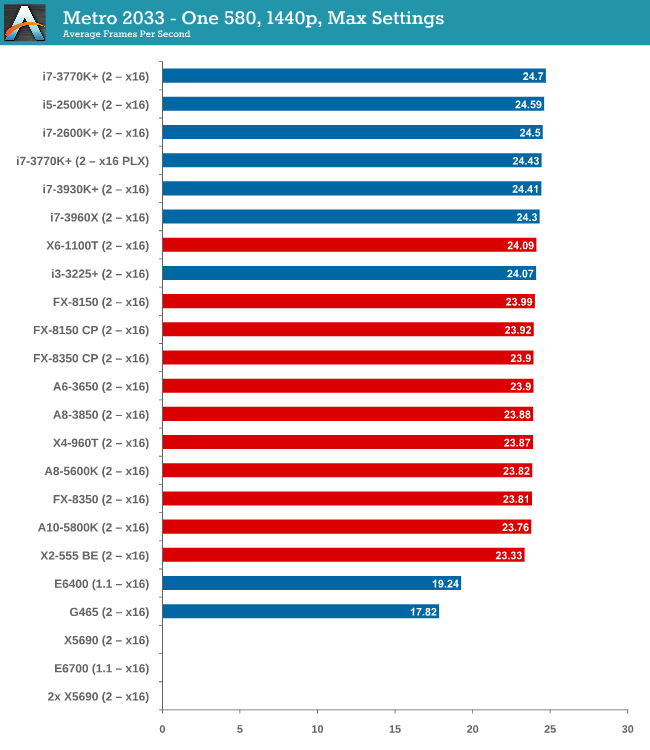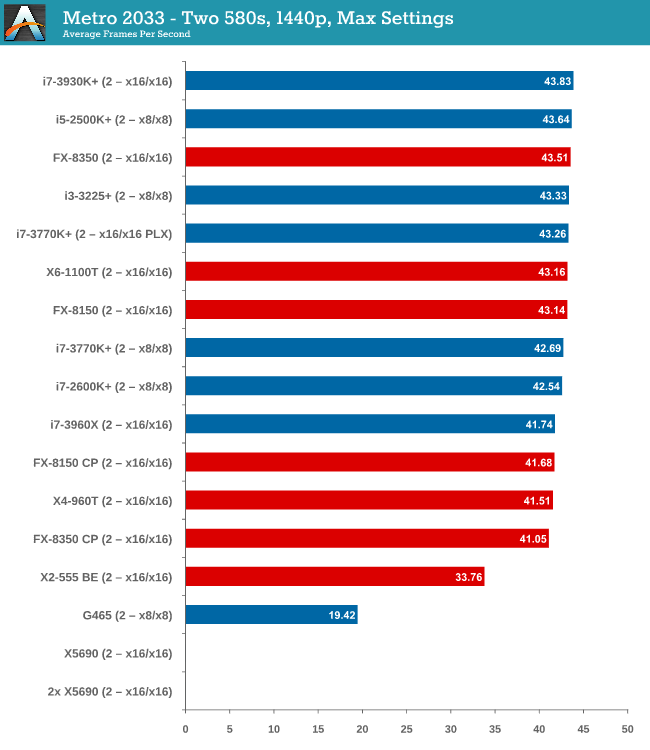Choosing a Gaming CPU: Single + Multi-GPU at 1440p, April 2013
by Ian Cutress on May 8, 2013 10:00 AM ESTMetro 2033
Our first analysis is with the perennial reviewers’ favorite, Metro 2033. It occurs in a lot of reviews for a couple of reasons – it has a very easy to use benchmark GUI that anyone can use, and it is often very GPU limited, at least in single GPU mode. Metro 2033 is a strenuous DX11 benchmark that can challenge most systems that try to run it at any high-end settings. Developed by 4A Games and released in March 2010, we use the inbuilt DirectX 11 Frontline benchmark to test the hardware at 1440p with full graphical settings. Results are given as the average frame rate from a second batch of 4 runs, as Metro has a tendency to inflate the scores for the first batch by up to 5%.
One 7970

With one 7970 at 1440p, every processor is in full x16 allocation and there seems to be no split between any processor with 4 threads or above. Processors with two threads fall behind, but not by much as the X2-555 BE still gets 30 FPS. There seems to be no split between PCIe 3.0 or PCIe 2.0, or with respect to memory.
Two 7970s

When we start using two GPUs in the setup, the Intel processors have an advantage, with those running PCIe 2.0 a few FPS ahead of the FX-8350. Both cores and single thread speed seem to have some effect (i3-3225 is quite low, FX-8350 > X6-1100T).
Three 7970s

More results in favour of Intel processors and PCIe 3.0, the i7-3770K in an x8/x4/x4 surpassing the FX-8350 in an x16/x16/x8 by almost 10 frames per second. There seems to be no advantage to having a Sandy Bridge-E setup over an Ivy Bridge one so far.
Four 7970s

While we have limited results, PCIe 3.0 wins against PCIe 2.0 by 5%.
One 580

From dual core AMD all the way up to the latest Ivy Bridge, results for a single GTX 580 are all roughly the same, indicating a GPU throughput limited scenario.
Two 580s

Similar to one GTX580, we are still GPU limited here.
Metro 2033 conclusion
A few points are readily apparent from Metro 2033 tests – the more powerful the GPU, the more important the CPU choice is, and that CPU choice does not matter until you get to at least three 7970s. In that case, you want a PCIe 3.0 setup more than anything else.










242 Comments
View All Comments
Pjotr - Wednesday, May 29, 2013 - link
He wasn't comparing the graphics cards. He was showing how much the CPU matters on an older (580) and newer (7970) card.SetiroN - Thursday, May 9, 2013 - link
Is MCT supposed to refer to SMT/Hyperthreading?I believe you're the only person in the world using that acronym. Where did you pull it from?
IanCutress - Wednesday, May 15, 2013 - link
MultiCore Turbo, as per my article on the subject: http://www.anandtech.com/show/6214/multicore-enhan...Sometimes called MultiCore Enhancement of MultiCore Acceleration. MCT is a compromise name.
DoTT - Thursday, May 9, 2013 - link
Ian, When I saw this article I thought I was hallucinating. It is exactly what I’ve been scrubbing the web looking for. I recently purchased a Korean 1440P IPS display (very happy with it) and it is giving my graphics card (4850X2) a workout for the first time. I’m running an older Phenom II platform and have been trying to determine what the advantages of just buying a new card are versus upgrading the whole platform. Most reviews looking at bottlenecking are quite old and are at ridiculously low resolutions. CPU benchmarks by themselves don’t tell me what I wanted to know. After all, I don’t push the system much except when gaming. This article hit the spot. I wanted to know how a 7950 or 7970 paired with my system would fare. An additional follow up would be to see if any slightly lower end cards (7870, 650Ti etc.) show any CPU related effects. I have been debating the merits of going with a pair of these cards vs a single 7970.Thanks for the great review.
phrank1963 - Thursday, May 9, 2013 - link
I use a G850 and 7700 would like to see lower end testing> I choose the g850 after looking a long time at benchmarks across the web.GamerGirl - Thursday, May 9, 2013 - link
very nice and helpfull article thx!smuff3758 - Thursday, May 9, 2013 - link
Thought we are banning you!spigzone - Thursday, May 9, 2013 - link
Also of note is Digital Foundry polling several developers whether they would recommend Intel or AMD as the better choice to future proof one's computer for next gen games. 100% recommended AMD over Intel.Obviously a lot going on behind the scenes here with AMD leveraging their console wins and deep involvement at every level of next gen game development. With that in mind one might expect Kaveri to be an absolute gaming beast.
http://www.eurogamer.net/articles/digitalfoundry-f...
evonitzer - Thursday, May 9, 2013 - link
Great read. I read through the article and the comments yesterday, but had a extra thought today. Sorry if it has been mentioned by somebody else, but there seems to be a lot of discussion about MMORPG's and their CPU demands. Perhaps you could just do a scaled down test with 3-4 CPU's to see how they handled an online scenario. It won't be perfectly repeatable, but it could give some general advice about what is being stressed. I would assume it is the CPU that is getting hit hard, but perhaps it is simply rendering that causes the FPS to decrease.Other than that, I would like to see my CPU tested, of course :) (Athlon II X4 630) But I think I can infer where my hardware puts me. Off the bottom of the charts!
Treckin - Thursday, May 9, 2013 - link
Great work, however I would certainly question 2 things:Why did you use 580GTXs? Anyone springing for 4 GPUs isnt going to go for two+ year old ones (a point you made yourself in the methodology section explaining why power consumption wasnt at issue here).
Why would you test all of this hardware for single monitor resolutions? Surely you must be aware that people using these setups (unless used for extreme overclocking or something) are almost certainly gaming at 3x1080p, 3x1440p, or even 3x1600p.
Also of concern to me would be 3d performance, although that may be a bit more niche then even 4GPU configurations.